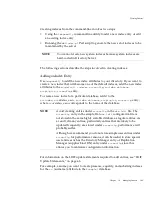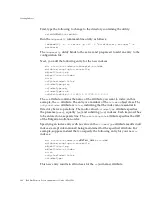
About Indexes
388
Red Hat Directory Server Administrator’s Guide • May 2005
Index Types
Directory Server supports six index types, which means that the index list will
allow up to six different types of searches, such as an exact match, a “sounds-like”
search, or a search on a string within the entry. The types of indexes are outlines
here:
•
Presence index (pres)
— The presence index contains a list of the entries that
contain a particular attribute. This index is useful if, for example, you want to
examine any entries that contain access control information. Generating an
aci.db3
file that includes a presence index lets you efficiently perform the
search for
ACI=*
to generate the Access Control List for the server.
The presence index is not used for base object searches.
•
Equality index (eq)
— The equality index allows you to search efficiently for
entries containing a specific attribute value. For example, an equality index on
the
cn
attribute allows a user to perform the search for
cn=Babs Jensen
far
more efficiently.
•
Approximate index (approx)
— The approximate index allows efficient
approximate or “sounds-like” searches. For example, an entry may include
the attribute value
cn=Robert E Lee
. An approximate search would return
this value for searches against
cn~=Robert Lee
,
cn~=Robert
, or
cn~=Lee
.
Similarly, a search against
l~=San Fransisco
(note the misspelling) would
return entries including
l=San Francisco
.
NOTE
While Directory Server can support the old database design, only
the new design is installed with the Directory Server. Upon startup,
the server will read the database version from the DBVERSION file,
which contains the text
Netscape-ldbm/6.2
(old database version)
and
Netscape-ldbm/7.1
(new database format). If the file indicates
that the old format is used, then the old code is selected for the
database. Because the DBVERSION file stores everything
per-backend, it is theoretically possible to have different database
formats for different individual backends. However, the old
database format is not recommended.
Migrate all databases to Directory Server 7.1 when the system is
upgraded. For releases earlier than version 6.2 or for large
databases, export the databases to LDIF, and install Directory Server
fresh. For more information, see chapter 6, “Migrating from
Previous Versions,” in the
Red Hat Directory Server Installation Guide.
Summary of Contents for DIRECTORY SERVER 7.1
Page 1: ...Administrator s Guide Red Hat Directory Server Version7 1 May 2005 Updated February 2009 ...
Page 20: ...20 Red Hat Directory Server Administrator s Guide May 2005 Glossary 619 Index 635 ...
Page 22: ...22 Red Hat Directory Server Administrator s Guide May 2005 ...
Page 26: ...26 Red Hat Directory Server Administrator s Guide May 2005 ...
Page 78: ...Maintaining Referential Integrity 78 Red Hat Directory Server Administrator s Guide May 2005 ...
Page 200: ...Assigning Class of Service 200 Red Hat Directory Server Administrator s Guide May 2005 ...
Page 488: ...488 Red Hat Directory Server Administrator s Guide May 2005 ...
Page 528: ...PTA Plug in Syntax Examples 528 Red Hat Directory Server Administrator s Guide May 2005 ...
Page 572: ...572 Red Hat Directory Server Administrator s Guide May 2005 ...
Page 612: ...Examples of LDAP URLs 612 Red Hat Directory Server Administrator s Guide May 2005 ...
Page 634: ...634 Red Hat Directory Server Administrator s Guide May 2005 ...
















































